| Construction Rating: | starstarstarstarstar_border |
| Flight Rating: | starstarstarstarstar_border |
| Overall Rating: | starstarstarstarstar_border |
| Manufacturer: | Sunward Aerospace  |
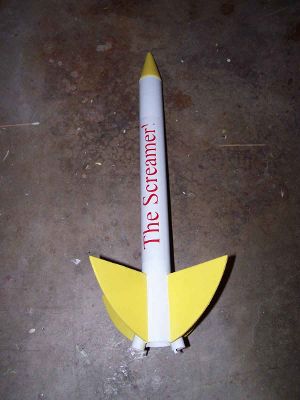
Brief:
The Screamer is my first try at a kit from Sunward Aerospace. I've used their components before but have not gotten
around to trying a kit until now. This one caught my interest because it is a 2 motor cluster, and I like clusters. I
also picked it because of its canted motor design. There are other canted motor designs but this is one I've only seen
ads for and have never seen a real example in person or through photos. That changes now.
Construction:
The first step given in the instructions is to cut out the wraparound guide. It is printed on a sheet by itself along
with a couple of paper strips intended for engine hook reinforcement. I generally prefer the wraps over other methods.
The wrap was cut out and set aside. I did not cut out the reinforcing bands.
The motor mounts were up next. A pair of marks was made one each tube at 3/16" and at 1-3/4". A slit was made at the aft mark and the engine hook inserted. At this point I was instructed to use the paper reinforcement wraps which had been provided but I elected to use electrical tape instead. I have long heard of its use in this capacity and intended to give it a try but never seemed to have any one hand. Now I do and I'm giving it a try. The tape was wrapped around each mount as the second mark.
The next step was a simple matter of seating the thrust rings right above the engine hooks with yellow glue.
Next came what the instructions described as the "most tedious part of the build". It was time to work on the canted housing. I was instructed to make a line across the center of the rear ring. I did so and was pretty pleased with myself until I realized that I had run it in the wrong direction. I had to make another line at a right angle to the first. The wedge piece was then glued in place with yellow glue and allowed to set.
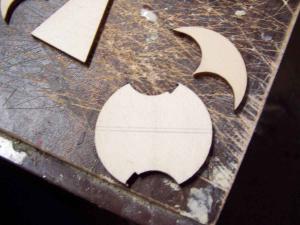
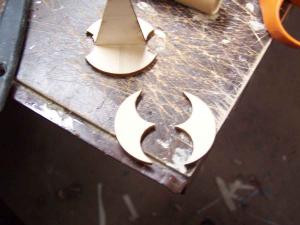
Next up was a problem. The forward ring in my package was broken into 2 pieces. [Note: this should not be taken as a reflection on Sunward Aerospace. It looks to be a delicate part at the best of times and this kit spent more than its share of time floating around boxes and such.] I decided to try and glue the two pieces together. It may work. At worst, I will have to wait as a replacement order comes in. Accordingly, a dab of yellow glue was placed on the break and the 2 pieces were pushed together.
After a night to let the glue dry on the angle, I took one of the motor tube and test fit it in the lower ring/angle. The lunette at the bottom of the ring has a notch cut out of it to accommodate the engine hook. I got this lined up and then set it in place with the edge of the motor tube flush with the top of the angle. It looked like it fit so I applied the first layer of a double glue joint, pressed the mount into place, and then removed it. A bit later, some more glue was applied and the mount put into place again. I found that I needed to tape the mount down in order to keep it properly aligned.
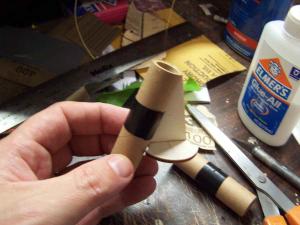
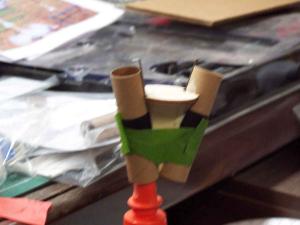
The first tube dried in the mount overnight and I removed the tape to inspect the results. It seemed OK although there are a few gaps between the tube and the angle support. Not having built something like this before I was unsure. Assuming that everything was alright, I tried the other mount and found it to be much the same as the first. It was again fitted with a double glue joint and taped into place to dry.
To start off the waiting process, I decided to work ahead a little bit. The next step was to put the wrap in place for the cutting of the tube. It was taped in place and fit perfectly, always a relief for me. It was aligned so that it was flush with the aft end and a piece of tape was used to hold it down. With the guide in place, the first task was to cut out the notches for the canted motors. I knew this was going to be done better if I did it right so I took some time to make a mandrel to support the tube as it was cut. The mandrel was inserted into the aft end of the BT, the end with the guide taped to it, and positioned so that the cutting area was supported. A razor knife was then drawn repeatedly over the marked line until the indicated segments were removed. At this point, I needed to test fit the motor mount but that was still drying so I went on to other projects for a while.
When the motor mount had dried, I took off the tape and tried to test fit the mount into the body tube. It seemed to fit just fine and I almost forgot that I had not yet put in the forward centering ring. That too had been drying from my patch job but the connection was so thin that it did not hold up to my manipulations. I decided I would have to try and glue it in place in pieces. While test fitting, I also had the realization of why paper wraps were provided to reinforce the engine hooks instead of tape being specified. The mounts are visible!
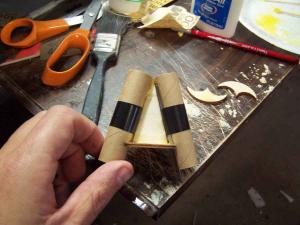
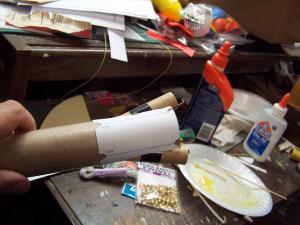
The fins, contrary to what was indicated in the instructions, were loose and not in any way joined to the parent stock material. They were of good quality and cleanly cut. I followed the instructions and just rounded the leading edges. You need to make sure you identify the proper grain direction. I brushed on some Elmer's Wood Filler, scraped it with a razor blade, and set them aside to dry.
Turning my attention back to the motor mount, I decided to let the split forward ring work for me. The kit is provided with a tri-fold mount for the shock cord. I absolutely detest these. I decided to use a fat piece of Kevlar® instead. I knotted the Kevlar® at one end and treaded it though the space between the two motor mounts. I then slathered yellow glue over it, fixing it to the triangular support. When dry, I applied some more glue.
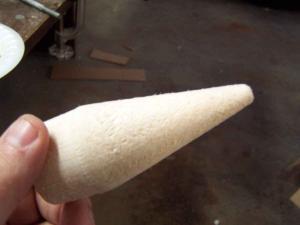 The nose
cone was not like the fins. Instead of being smooth, it was one of the fuzziest I had ever seen. I slathered on the
filler and set it aside to dry.
The nose
cone was not like the fins. Instead of being smooth, it was one of the fuzziest I had ever seen. I slathered on the
filler and set it aside to dry.
Though I did not manage to glue the pieces of the forward centering ring back together and have them stay together, I did manage to glue the pieces into the right place on the motor mount. When dry, they even fit well! Since the dry fitting went well, I swabbed the tail of the BT with yellow glue and inserted the mount. It seemed steady and I hoped for the best. A few days later, when I next had a chance to work on this one, everything seemed fine.
It was time to start mounting the fins. I removed the wrap and used an angle to extend the fin lines. A pushpin was then used to make perforations along the lines in the hope of forming a better glue joint. Then it was a matter of beginning to glue on the fins. I used yellow glue and a double glue joint. The gluing of the fins took place over the course of 3 days. I wanted to let the first glue joint dry completely before doing the second and attaching the fins. When the fins had dried in place, I began the process of filleting them with white glue.
The filler on the nose cone had had a chance to dry and I sanded it down. That dramatically improved things but I was still having a problem with the fuzzies peeking through. I went ahead and glued in the screw eye and then began to drizzle thin CA over the nosecone in the hope that it would harden things up and made it sand easier.
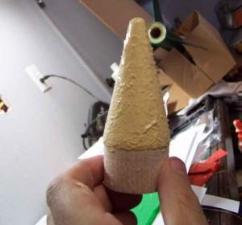
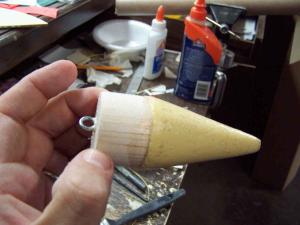
After what seemed like an excessing amount of filleting, the Screamer seemed ready to move to the finishing stage.
Finishing:
The fins had been sealed with Elmer's Wood Filler and sanded during construction. Now what needed to be done was to
prime the rocket. It was taken to the booth and given a coat of Kilz. Because of the way the rocket was stood up, it
was apparent that another good coat would be needed to complete the job.
Another coat was applied and then the rocket was sanded down with #400 sandpaper. It was then set up in the booth and sprayed with my dwindling supply of the old Krylon gloss white.
I wound up putting on three coats of the gloss white and the result was satisfactory. The rocket was then masked for yellow, leaving only the nosecone and fins exposed.
The rocket was put in the booth and given three light coats of a medium-light yellow. Even with the masking, the added bit of color really added a lot to the appearance.
A few hours later, I peeled off the masking and the rocket was starting to look like the face card.\
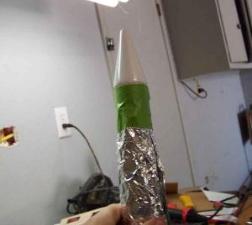
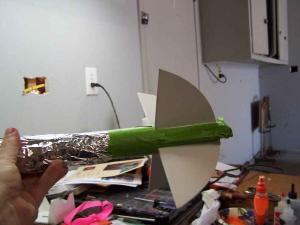
All that was left, so I thought, was to apply the decal. It was to be a simple matter. The decal consists just of the rocket name. It had been peeking at me through the bag since I started this project. Imagine then my surprise when I reached in to pull it out only to find there was no decal. It's a sticker.
It did apply fairly easily, but I sure like waterslides better and, personally, I am willing to pay for them.
As it turns out, I was not done. I realized that, in accordance with my custom, I had again forgotten the launch lug. I scraped off a bit of paint and applied it with some white glue.
Construction Rating: 4 out of 5
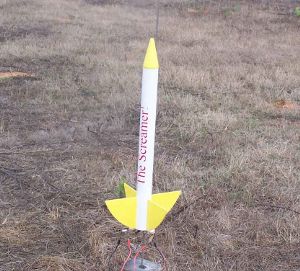
Flight and Recovery:
The day of the maiden flight came and I realized that I did not bring my box of chutes. I was not planning on using
the plastic chute that came with a kit because I usually substitute nylon. The box, however, was left behind. I did
have a bunch of 4" streamers from Hartle Engineering (Thanks, Evil Ed) and decided to use one of them.
I loaded a pair of B6-4s and set the Screamer on the pad. It took off flawlessly, going straight up. Ejection was perfect but it was soon apparent that the lengthened streamer cord got wrapped around a fin. It came in hard enough to tear away one of the fins where the cut is made for the canted motor. It will be repaired but was destined not to fly again this day. A video of the maiden flight can be seen here.
Flight Rating: 4 out of 5
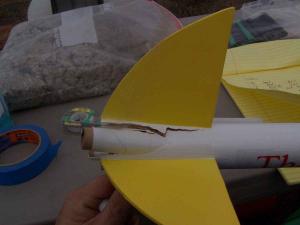
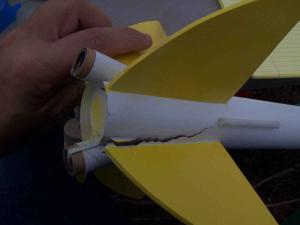
Summary:
I enjoyed this rocket. It flew well and will be repaired to fly again. Next time, however, I will have a
parachute ready for it.
Overall Rating: 4 out of 5
 |
 |
Flights
 |
 |
 |
 |
W.C. (May 10, 2009)